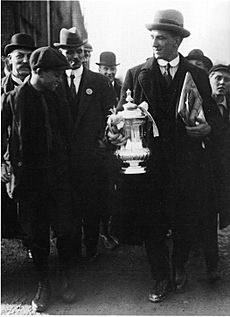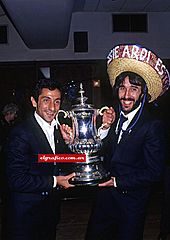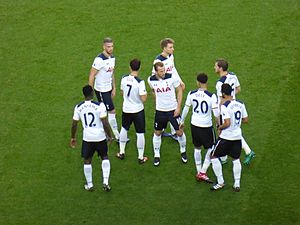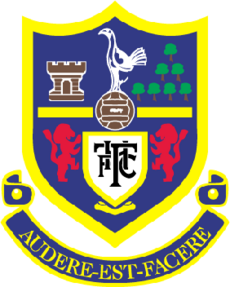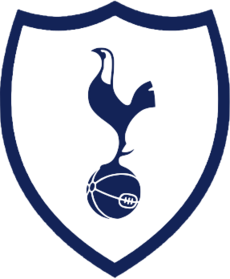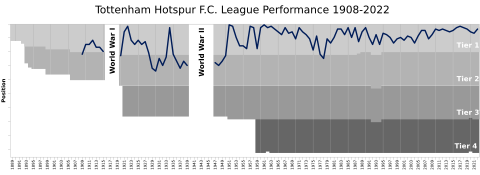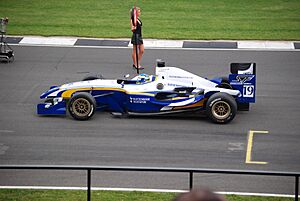Tottenham Hotspur F.C. facts for kids
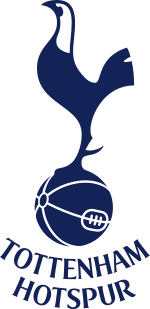 |
|||
| Full name | Tottenham Hotspur Football Club | ||
|---|---|---|---|
| Nickname(s) | The Lilywhites | ||
| Short name | Spurs | ||
| Founded | 5 September 1882, as Hotspur F.C. | ||
| Ground | Tottenham Hotspur Stadium | ||
| Capacity | 62,850 | ||
| Owner | ENIC International Ltd. (86.58%) | ||
| Chairman | Daniel Levy | ||
| Head coach | Thomas Frank | ||
| League | Premier League | ||
| 2018–19 | Premier League, 4th of 20 | ||
|
|
|||
Tottenham Hotspur Football Club, often called Tottenham or Spurs, is a professional football team. They are based in Tottenham, North London, England. The club plays in the Premier League, which is the top football league in England. Since 2019, their home games have been at the Tottenham Hotspur Stadium. This new stadium was built on the same spot as their old home, White Hart Lane.
Tottenham Hotspur was started in 1882. Their symbol is a cockerel (a rooster) standing on a football. Their Latin motto is Audere est Facere, which means "to dare is to do." The team has always worn white shirts and navy blue shorts for their home games since the 1898–99 season. Their training ground is called Hotspur Way in Bulls Cross, Enfield.
Tottenham won the FA Cup for the first time in 1901. They were the only team not in the main Football League to do this since the league began in 1888. In the 20th century, Tottenham was the first club to win both the League and FA Cup in the same year. This happened in the 1960–61 season. They won the FA Cup again in 1962. In 1963, they became the first British club to win a UEFA club competition, the European Cup Winners' Cup. They also won the first UEFA Cup in 1972. This made them the first British club to win two different major European trophies. From the 1950s to the 2000s, they won at least one major trophy in every decade. Only Manchester United has matched this achievement.
In England, Spurs have won two league titles, eight FA Cups, four League Cups, and seven FA Community Shields. In Europe, they have won one European Cup Winners' Cup and three UEFA Cup/Europa League titles. Tottenham also reached the final of the 2018–19 UEFA Champions League in 2019. They have a big rivalry with nearby club Arsenal, which is called the North London derby. They also have a rivalry with Chelsea. ENIC Group has owned Tottenham since 2001. In 2024, the club was valued at about £2.6 billion ($3.2 billion). It was the ninth-highest-earning football club in the world, with £615 million in revenue in 2024.
Contents
Club History
How Tottenham Hotspur Started (1882–1908)
The club was first called Hotspur Football Club. It was started on September 5, 1882, by a group of schoolboys. They were part of the Hotspur Cricket Club and wanted to play sports in winter. A year later, a teacher named John Ripsher helped them. He became the club's first president. In April 1884, the club changed its name to "Tottenham Hotspur Football Club." This was to avoid confusion with another club called Hotspur. People also call the club "Spurs" or "the Lilywhites."
At first, the team played friendly games against other local clubs. Their first recorded match was on September 30, 1882, against the Radicals, which they lost 2–0. They entered their first cup competition, the London Association Cup, in 1885. They won their first competitive match 5–2 against St Albans. More and more people came to watch their games. In 1892, they played in a league for the first time, called the Southern Alliance.
The club became professional on December 20, 1895. In 1896, they joined Division One of the Southern Football League. On March 2, 1898, the club became a limited company. Soon after, Frank Brettell became Spurs' first manager. He signed John Cameron, who became player-manager when Brettell left. Cameron helped the club win its first trophy, the Southern League title, in the 1899–1900 season. The next year, Spurs won the 1901 FA Cup. They beat Sheffield United 3–1 in a replay after a 2–2 draw. This made them the only non-League club to win the FA Cup since the Football League started in 1888.
Joining the Football League (1908–1958)
In 1908, Tottenham joined the Football League Second Division. They were promoted to the First Division in their first season, finishing second. In 1912, Peter McWilliam became manager. Tottenham finished last in the league in 1914–15 before football stopped for the First World War. After the war, Spurs were relegated but quickly returned to the First Division. They won the Second Division championship in the 1919–20 season.
On April 23, 1921, McWilliam led Spurs to their second FA Cup win. They beat Wolverhampton Wanderers 1–0 in the final. After finishing second in the league in 1922, they spent five seasons in the middle of the table. They were relegated in the 1927–28 season after McWilliam left. For most of the 1930s and 1940s, Spurs played in the Second Division. They briefly returned to the top league in the 1933–34 and 1934–35 seasons.
Former Spurs player Arthur Rowe became manager in 1949. Rowe created a playing style called "push and run" which was very successful. He led the team back to the First Division by winning the Second Division in the 1949–50 season. In his second season, Tottenham won their first ever top-tier league title in the 1950–51 season. Rowe left in April 1955 due to stress. Before he left, he signed Danny Blanchflower, one of Spurs' most famous players. Blanchflower won the FWA Footballer of the Year award twice while at Tottenham.
The Glory Years with Bill Nicholson (1958–1974)
Bill Nicholson became manager in October 1958. He became the club's most successful manager. He led the team to win major trophies three seasons in a row in the early 1960s. They won the Double (League and FA Cup) in 1961, the FA Cup in 1962, and the Cup Winners' Cup in 1963. Nicholson signed Dave Mackay and John White in 1959. These two players were very important to the Double-winning team. He also signed Jimmy Greaves in 1961, who became the top goal-scorer in English top-tier football history.
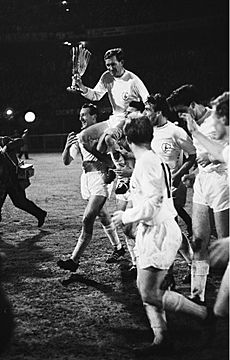
The 1960–61 season started with 11 wins in a row. This was the best start ever by any club in English top-flight football at the time. They won the league title on April 17, 1961, by beating Sheffield Wednesday 2–1 at home. They still had three games left to play. The Double was completed when Spurs won 2–0 against Leicester City in the FA Cup final. This was the first Double of the 20th century. The next year, Spurs won their second FA Cup in a row, beating Burnley in the 1962 FA Cup final.
On May 15, 1963, Tottenham became the first British team to win a European trophy. They won the 1962–63 European Cup Winners' Cup by beating Atlético Madrid 5–1 in the final. Spurs also became the first British team to win two different European trophies. They won the 1971–72 UEFA Cup with a new team that included Martin Chivers, Pat Jennings, and Steve Perryman. They also won the FA Cup in 1967, two League Cups (in 1971 and 1973). In total, Nicholson won eight major trophies in his 16 years as manager.
From Burkinshaw to Venables (1974–1992)
Spurs had a difficult period after the successes of the early 1970s. Nicholson resigned after a bad start to the 1974–75 season. The team was then relegated at the end of the 1976–77 season with Keith Burkinshaw as manager. Burkinshaw quickly brought the club back to the top league. He built a team that included Glenn Hoddle and two Argentinian players, Osvaldo Ardiles and Ricardo Villa. It was unusual to have players from outside the British Isles at that time. The team Burkinshaw built went on to win the FA Cup in 1981 and 1982, and the UEFA Cup in 1984.
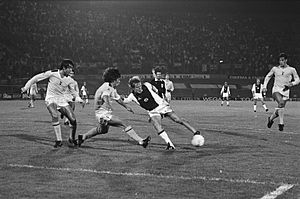
The 1980s brought many changes. There was a new phase of building at White Hart Lane. Also, the club's leadership changed. Irving Scholar took over and made the club more focused on business. This was the start of English football clubs becoming commercial companies. Debts at the club led to another change in leadership. In June 1991, Terry Venables joined with businessman Alan Sugar to take control of Tottenham Hotspur. Venables, who became manager in 1987, signed players like Paul Gascoigne and Gary Lineker. Under Venables, Spurs won the 1990–91 FA Cup. This made them the first club to win eight FA Cups.
Premier League Era (1992–Present)
Tottenham was one of five clubs that helped create the Premier League. This new league replaced the Football League First Division as the highest division in English football. In February 2001, Sugar sold his shares in Spurs to ENIC Sports plc. This company was run by Joe Lewis and Daniel Levy. Lewis and Levy eventually owned 85% of the club, with Levy managing the club's daily operations. For a long time in the Premier League, until the late 2000s, Spurs often finished in the middle of the table. They won few trophies during this period. They won the League Cup in 1999 under George Graham. They won it again in 2008 under Juande Ramos. Performance improved under Harry Redknapp with players like Gareth Bale and Luka Modrić. The club finished in the top five in the early 2010s.
After Redknapp left, Mauricio Pochettino became head coach from 2014 to 2019. Under Pochettino, with new stars like Harry Kane (who came from the club's own youth academy) and Son Heung-min from Korea, Tottenham became one of the "Big Six" clubs. Spurs finished second in the 2016–17 season. This was their highest league finish since the 1962–63 season. They also reached the UEFA Champions League final in 2019, their first ever. They lost 2–0 to Liverpool. During Pochettino's last few seasons, the club played home games at Wembley Stadium while the new Tottenham Hotspur Stadium was being built.
Pochettino was let go after a poor start to the 2019–20 season. José Mourinho replaced him, managing from November 2019 to April 2021. His successor, Nuno Espírito Santo, only lasted four months. The next manager, Antonio Conte, led Spurs to fourth place in the 2021–22 season, getting them back into the Champions League. He left the club in March 2023. In February 2023, Harry Kane became the club's all-time top goalscorer, passing Jimmy Greaves. Kane left Spurs at the end of that season to join Bayern Munich.
Ange Postecoglou became head coach on July 1, 2023. The club finished fifth in the Premier League, which meant they qualified for the 2024–25 UEFA Europa League. In the 2024–25 season, the club ended their 17-year wait for a trophy. They won the 2025 Europa League final with a 1–0 victory over Manchester United. However, they finished only 17th in the Premier League. This was their worst league performance in the Premier League era. As a result, Postecoglou was dismissed. Thomas Frank was then brought in as the new head coach.
Stadiums
Early Playing Fields
Spurs first played their games on public land at Tottenham Marshes. They had to mark out their own pitch there. Sometimes, fights would happen with other teams over using the field. The first Spurs game reported by local news was on October 6, 1883, against Brownlow Rovers. Spurs won that game 9–0. In 1887, Spurs first played against the team that would become their biggest rivals, Arsenal (then called Royal Arsenal). Spurs were leading 2–1, but the game was stopped because it got too dark.

Since they played on public land, the club could not charge people to watch. Even though a few thousand fans came, the club made no money from tickets. In 1888, the club rented a pitch at Northumberland Park for £17 a year. They charged 3d (threepence) to watch a game, which went up to 6d for cup matches. The first game at Northumberland Park was on October 13, 1888. It was a reserve team match and brought in 17 shillings from tickets. A small stand with over 100 seats was built for the 1894–95 season. It cost £60. However, the stand was blown down a few weeks later and had to be fixed. In April 1898, 14,000 fans came to watch Spurs play Woolwich Arsenal. Some fans climbed on the roof of a refreshment stand to see better. The stand collapsed, causing some injuries. Because Northumberland Park could not handle such large crowds, Spurs looked for a bigger ground. They moved to the White Hart Lane site in 1899.
White Hart Lane Stadium
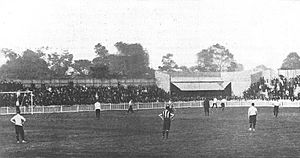
The White Hart Lane stadium was built on land that used to be a plant nursery. It was behind a pub called the White Hart on Tottenham High Road. The club first rented the land. They moved the stands they used at Northumberland Park to this new site. These stands could shelter 2,500 fans. Notts County was the first team to visit 'the Lane' for a friendly game. 5,000 people watched, and Spurs won 4–1. Queens Park Rangers were the first team Spurs played in a competitive match at the ground. 11,000 people watched Tottenham win 1–0. In 1905, Tottenham raised enough money to buy the land.
After Spurs joined the Football League, the club started building a new stadium. Stands designed by Archibald Leitch were built over the next 25 years. The West Stand was added in 1909. The East Stand was also covered that year and made bigger two years later. Money from the 1921 FA Cup win was used to build a covered area at the Paxton Road end. The Park Lane end was built about two years later for over £3,000. This made the stadium's capacity about 58,000, with space for 40,000 under cover. The East Stand was finished in 1934. This increased the capacity to about 80,000 fans and cost £60,000.

Starting in the early 1980s, the stadium was rebuilt again. The West Stand was replaced with an expensive new structure in 1982. The East Stand was updated in 1988. In 1992, after new rules said Premier League clubs could not have standing areas, the lower parts of the south and east stands were changed to seats. The North Stand became all-seater the next season. The South Stand was finished in March 1995. It included the first giant Sony Jumbotron TV screen for live game coverage. In the 1997–98 season, the Paxton Road stand got a new upper level and a second Jumbotron screen. Small changes were made to the seating in 2006, bringing the stadium's capacity to 36,310.
By the year 2000, White Hart Lane's capacity was smaller than other big Premier League clubs. The club discussed what to do next. They thought about making the current stadium bigger or using the 2012 London Olympic Stadium. Eventually, the club decided on the Northumberland Development Project. This meant building a new stadium on a larger piece of land that included the old site. In 2016, part of the old stadium was removed to help build the new one. Because this made the stadium too small for European games, Tottenham Hotspur played all their European home games in 2016–17 at Wembley Stadium. Domestic games in the 2016–17 season were still played at White Hart Lane. But demolition of the rest of the stadium started the day after the last game of the season. White Hart Lane was completely gone by the end of July 2017.
Tottenham Hotspur Stadium

In October 2008, the club announced plans for a new stadium. It would be built just north of the old White Hart Lane. The southern part of the new stadium's pitch would overlap the northern part of the old Lane. This plan became the Northumberland Development Project. The club applied for permission in October 2009. However, after some negative feedback, they changed the plan. A new, much improved plan for the stadium was submitted and approved in September 2010. An agreement for the project was signed on September 20, 2011.
There was a long delay because of legal challenges over buying land from local businesses. This was resolved in early 2015. A new design for the stadium was approved on December 17, 2015. Construction started in 2016. The new stadium was planned to open during the 2018–19 season. While it was being built, all Tottenham home games in the 2017–18 season and most games in 2018–19 were played at Wembley Stadium. After two successful test events, Tottenham Hotspur officially moved into the new stadium on April 3, 2019. Their first game there was a Premier League match against Crystal Palace, which Spurs won 2–0. The new stadium is called Tottenham Hotspur Stadium while the club looks for a company to buy the naming rights.
Training Grounds
An early training ground for Tottenham was at Brookfield Lane in Cheshunt, Hertfordshire. The club bought this 11-acre ground in 1952 for £35,000. It had three pitches, including a small stadium for junior team matches. The ground was later sold for over £4 million. The club then moved its training ground to Spurs Lodge in Chigwell, Essex. This opened in September 1996. The training ground in Chigwell was used until 2014.
In 2007, Tottenham bought land at Bulls Cross in Enfield. This was a few miles south of their old ground in Cheshunt. A new training ground was built there for £45 million, opening in 2012. The 77-acre site has 15 grass pitches and one and a half artificial pitches. It also has a covered artificial pitch inside the main building. The main building on Hotspur Way also has pools, gyms, medical rooms, and dining areas for players. It also has classrooms for young academy players. A 45-bedroom lodge for players was added next to the training site in 2018. This lodge is mainly used by Tottenham's first team and Academy players. National football teams, like the Brazilian team before the 2018 FIFA World Cup, have also used these facilities.
Club Crest
Since the 1921 FA Cup Final, the Tottenham Hotspur crest has featured a cockerel. Harry Hotspur, who the club is named after, was known for digging in his spurs to make his horse go faster in battles. Spurs are also linked to fighting cocks. The club used spurs as a symbol in 1900, which then became a fighting cock. A former player named William James Scott made a bronze statue of a cockerel standing on a football. This statue cost £35 and was placed on top of the West Stand in 1909–10. Since then, the cockerel and ball symbol has been a key part of the club's identity. The club badge on the shirt in 1921 showed a cockerel inside a shield. This changed to a cockerel sitting on a ball in the late 1960s.
Between 1956 and 2006, Spurs used a shield-like crest. It showed local landmarks and symbols. The castle is Bruce Castle, which is near the stadium. The trees are the Seven Sisters. The crest also had the Latin motto Audere Est Facere (to dare is to do).
In 1983, to stop people from illegally copying their logo, the club's badge was changed. Two red lions were added to the sides of the shield. These lions came from the family crest of the Northumberland family, which Harry Hotspur was part of. The motto scroll was also added. This design appeared on Spurs' playing kits from 1996 to 1999.
In 2006, the club changed its badge to a new, modern design. This new logo showed a sleeker cockerel standing on an old-style football. The club said they would only use this new logo on their playing kits. In November 2013, Tottenham asked a smaller club, Fleet Spurs, to change their badge. Tottenham said Fleet Spurs' new design was "too similar" to their own crest.
In 2017, Spurs added a shield around the cockerel logo on their shirts. This was similar to the 1950s badge but with the modern cockerel design. However, the shield was removed the following season.
Team Kit
The first Tottenham kit in 1883 included a navy blue shirt with a letter H on a red shield. They also wore white shorts. In 1884 or 1885, the club changed to a "quartered" kit, similar to Blackburn Rovers. After moving to Northumberland Park in 1888, they went back to navy blue shirts for the 1889–90 season. Their kit changed again in 1890 to a red shirt and blue shorts. For a while, the team was known as 'the Tottenham Reds'. Five years later, in 1895, when they became a professional club, they switched to a chocolate and gold striped kit.
In the 1898–99 season, their last year at Northumberland Park, the club changed to white shirts and blue shorts. These were the same colors as Preston North End. White and navy blue have been the club's main colors ever since. The white shirts gave the team the nickname "The Lilywhites." In 1921, the year they won the FA Cup, the cockerel badge was added to the shirt for the final. A club crest has been on the shirt ever since. Spurs became the first major club to have their crest on the players' shirts for every match, except during the war years. In 1939, numbers first appeared on the backs of the shirts.
In the early days, local shops sold the team's kits. An early supplier was HR Brookes. In the 1920s, Bukta made the jerseys for the club. From the mid-1930s, Umbro supplied the kits for forty years. In 1959, the V-neck shirt replaced the old collared shirts. Then, in 1963, the crew neck shirt appeared. In 1961, manager Bill Nicholson had Spurs players wear white shorts instead of navy for their European games. This tradition continues today in European competitions.
In 1977, a deal was signed with Admiral to supply the team's kits. While Umbro had sold generic colored kits to fans since 1959, the Admiral deal helped the market for replica shirts grow. Admiral changed the simple designs to shirts with more detailed patterns. These included manufacturer logos, stripes down the arms, and trims. Admiral was replaced by Le Coq Sportif in 1980. In 1985, Spurs partnered with Hummel to supply their kits. However, Tottenham's attempt to expand the business side of the club did not work out. In 1991, they returned to Umbro. In 1991, the club was the first to wear long-cut shorts. This was new at a time when football kits had shorts cut well above the knee. Pony followed Umbro in 1995, then Adidas in 1999, Kappa in 2002, and Puma in 2006. In March 2011, Under Armour announced a five-year deal to supply Spurs with shirts starting in 2012–13. These shirts included technology to monitor players' heart rate and temperature. In June 2017, Nike became their new kit supplier. The 2017–18 kit featured the Spurs' crest inside a shield, honoring their 1960–61 season. In October 2018, Nike agreed to a 15-year deal, reportedly worth £30 million a year, to supply kits until 2033.
Shirt sponsorship in English football started with a non-league club in 1976. The ban on sponsors was lifted, and major clubs started using them. In December 1983, Holsten became the first sponsor logo on a Spurs shirt. When Thomson became the sponsor in 2002, some Tottenham fans were unhappy because the logo was red. Red is the color of their rivals, Arsenal. In 2006, Tottenham signed a £34 million sponsorship deal with Mansion.com. In July 2010, Spurs announced a two-year shirt sponsorship with Autonomy worth £20 million. A month later, they revealed a £5 million deal with Investec for Champions League and domestic cup games. Since 2014, AIA has been the main shirt sponsor. This deal was initially worth over £16 million annually. It increased to £40-45 million per year in 2019, lasting until 2027. In 2023, Tottenham agreed to a three-year shirt sponsorship deal with South Africa Tourism (SAT).
|
|
|
|
|
Kit Suppliers and Shirt Sponsors
| Period | Kit manufacturer | Shirt sponsor (chest) | Shirt sponsor (sleeve) |
|---|---|---|---|
| 1907–1911 | HR Brookes | None | None |
| 1921–1930 | Bukta | ||
| 1935–1977 | Umbro | ||
| 1977–1980 | Admiral | ||
| 1980–1983 | Le Coq Sportif | ||
| 1983–1985 | Holsten | ||
| 1985–1991 | Hummel | ||
| 1991–1995 | Umbro | ||
| 1995–1999 | Pony | Hewlett-Packard | |
| 1999–2002 | Adidas | Holsten | |
| 2002–2006 | Kappa | Thomson Holidays | |
| 2006–2010 | Puma | Mansion.com Casino & Poker | |
| 2010–2011 | Autonomy Corporation | ||
| 2011–2012 | Aurasma | ||
| 2012–2013 | Under Armour | ||
| 2013–2014 | HP | ||
| 2014–2017 | AIA | ||
| 2017–2021 | Nike | ||
| 2021–2024 | Cinch | ||
| 2024–present | Kraken |
Club Ownership
Tottenham Hotspur F.C. became a limited company on March 2, 1898. This was done to raise money for the club and limit the financial risk for its members. 8,000 shares were offered at £1 each. By 1905, 4,892 shares had been sold. A few families, like the Wale, Richardson, and Bearman families, owned many shares. Members of these families were chairmen of Tottenham Hotspur F.C. from 1943 to 1984.
In the early 1980s, building a new West Stand cost more than expected. This, along with the cost of rebuilding the team, led to debts. In November 1982, a fan named Irving Scholar bought 25% of Tottenham for £600,000. He and Paul Bobroff took control of the club. To get more money, Scholar made Tottenham Hotspur a public company in 1983. This meant people could buy and sell shares in the company on the London Stock Exchange. It was the first European sports club to do this. The shares sold quickly. However, some bad business decisions under Scholar led to financial problems. In June 1991, Terry Venables and businessman Alan Sugar bought the club together. Sugar later increased his ownership and had control of the club. In May 1993, Venables was removed from the board after a disagreement. By 2000, Sugar wanted to sell the club. In February 2001, he sold most of his shares to ENIC International Ltd.
The main owner, ENIC International Ltd, is an investment company started by British billionaire Joe Lewis. Daniel Levy, Lewis's partner at ENIC, is the Executive Chairman of the club. They first bought 29.9% of the club's shares in 1991. ENIC's ownership grew over the years. They bought Alan Sugar's remaining shares in 2007 for £25 million. In 2009, they bought shares from Stelios Haji-Ioannou. In 2009, the club announced they had issued 30 million more shares to help pay for the new stadium. ENIC bought 27.8 million of these new shares. By 2010, ENIC owned 76% of all regular shares and 97% of other special shares, meaning they owned 85% of the club. The remaining shares are owned by over 30,000 people. From 2001 to 2011, Tottenham Hotspur F.C. shares were listed on the Alternative Investment Market. In January 2012, Tottenham Hotspur confirmed that the club had removed its shares from the stock market, making it a private company.
Lewis's shares are owned by the Lewis Family Trusts. In October 2022, Lewis was no longer listed as a person with significant control of the club after changes to the Trusts. The club is still owned by Levy and the Lewis trusts. In the summer of 2022, ENIC planned to invest up to £150 million into the club by issuing new shares. Only £100 million of shares were bought, which increased ENIC's ownership to 86.58%.
Fan Support
Tottenham has many fans in the United Kingdom, especially in North London. The number of people attending their home games has changed over the years. Five times between 1950 and 1962, Tottenham had the highest average attendance in England. Tottenham was 9th in average attendances for the 2008–09 Premier League season. In the 2017–18 season, when Tottenham used Wembley as their home ground, they had the second-highest attendance in the Premier League. They also hold the record for attendance in the Premier League, with 83,222 people watching the North London derby on February 10, 2018. Famous supporters of the club include the philosopher A. J. Ayer. There are many official fan clubs around the world. The Tottenham Hotspur Supporters' Trust is an independent fan club recognized by the club.
Historically, the club had many Jewish followers from Jewish communities in London. In the 1930s, about a third of its supporters were estimated to be Jewish. Because of this early support, all three chairmen of the club since 1984 have been Jewish businessmen who supported the club. Today, the club does not have more Jewish fans than other major London clubs. However, rival fans still sometimes call it a Jewish club. Since the 1960s, some rival fans have used offensive chants against the club and its supporters. In response, Tottenham supporters, both Jewish and non-Jewish, started using some of these words themselves, like "Yids" or "Yid Army," starting in the late 1970s or early 1980s. Some fans believe using "Yid" makes the insult less powerful. However, using "Yid" as a self-identification is controversial. Some argue that the word is offensive and that its use by Spurs fans makes it seem acceptable to use such terms in football. Both the World Jewish Congress and the Board of Deputies of British Jews have spoken out against fans using the word. Others, like former Prime Minister David Cameron, have argued that when Spurs fans use it, it is not meant to be hateful. Attempts to punish Tottenham fans for chanting the words have failed. This is because the Crown Prosecution Service decided that the words, as used by Tottenham fans, could not be legally considered "threatening, abusive or insulting."
Fan Culture
There are several songs linked to the club that Spurs fans often sing. One famous song is "Glory Glory Tottenham Hotspur." This song started in 1961 after Spurs won the Double in 1960–61. They then played in the European Cup for the first time. Their first opponents were Górnik Zabrze from Poland. Spurs lost the first game 4–2. The Polish press wrote that Spurs "were no angels" because of their tough playing style. This made three Spurs fans angry. For the return match, they dressed as angels, wearing white sheets, sandals, and fake beards. They carried signs with Bible-like sayings. The angels were allowed near the pitch, and their energy got the home fans excited. The fans then sang "Glory Glory Hallelujah," which is still sung at White Hart Lane and other football grounds. Spurs won the return game 8–1. Bill Nicholson, the manager at the time, wrote in his book: "A new sound was heard in English football in the 1961–62 season. It was the hymn Glory, Glory Hallelujah being sung by 60,000 fans at White Hart Lane in our European Cup matches. I don't know how it started or who started it, but it took over the ground like a religious feeling."
There have been some incidents of football hooliganism involving Spurs fans, especially in the 1970s and 1980s. For example, there were riots by Spurs fans in Rotterdam during the 1974 UEFA Cup final against Feyenoord. There were also incidents during the 1983–84 UEFA Cup matches against Feyenoord and Anderlecht. While fan violence has decreased, occasional incidents are still reported.
Rivalries
Tottenham supporters have rivalries with several clubs, mostly in London. Their biggest rivalry is with north London rivals Arsenal. This rivalry started in 1913 when Arsenal moved to Arsenal Stadium, Highbury. The rivalry grew stronger in 1919 when Arsenal was unexpectedly promoted to the First Division. Tottenham believed that spot should have been theirs.
Tottenham also has rivalries with other London clubs like Chelsea and West Ham United. The rivalry with Chelsea is less important than the North London derby. It began when Spurs beat Chelsea in the 1967 FA Cup final, which was the first all-London final. West Ham fans see Tottenham as a big rival. However, Tottenham fans do not feel the same strong rivalry towards West Ham.
Social Responsibility
Since 2006, the club has worked with Haringey Council and the Metropolitan Housing Trust through its Community Programme. They develop sports facilities and social programs. These programs have also received money from Barclays Spaces for Sport and the Football Foundation. The Tottenham Hotspur Foundation was launched at 10 Downing Street in February 2007, with support from the prime minister.
In March 2007, the club announced a partnership with the charity SOS Children's Villages UK. Player fines would go to this charity's children's village in Rustenburg, South Africa. This supported community development projects in and around Rustenburg. In the 2006–07 financial year, Tottenham gave the most money to charity among Premier League clubs. They gave £4,545,889, including a one-time contribution of £4.5 million over four years to set up the Tottenham Hotspur Foundation. In recent years, the foundation has run business creation "bootcamps" and given money to young business owners to help them start their companies.
However, the club successfully reduced its required payments for community projects related to the new stadium. The original plan included 50% affordable housing, but this was later removed. A payment of £16 million for community infrastructure was reduced to £500,000. This has caused controversy in an area with high poverty. Spurs bought properties for redevelopment, removing existing jobs and businesses, but did not create enough new jobs for the area. The club argued that the project, once finished, would support 3,500 jobs. They also said it would bring an estimated £293 million into the local economy each year. They believe it will help a wider 20-year plan to improve the Tottenham area. In other developments in Tottenham, the club has built 256 affordable homes and a primary school for 400 students.
London Academy of Excellence
As part of building the Tottenham Hotspur Stadium, the club built a top-level educational facility next to its offices. The London Academy of Excellence Tottenham (LAET) is a state-funded Sixth Form. It is sponsored by the Club and Highgate School, who provide expert teaching. LAET was named the Sunday Times Sixth Form College of the Year in 2020. In 2022, LAET received an "Outstanding" rating from Ofsted, which inspects schools.
Environmental Efforts
Spurs are one of the well-known participants in the 10:10 project, which they joined in 2009. In one year, their carbon emissions were reduced by 14%, about 400 tonnes of carbon. The club also stated it wants to reduce its carbon emissions by 50% by 2030 and become net-zero by 2040.
In September 2021, the club worked with Sky Sports to host the world's first net-zero carbon top-level football game. This effort won an award in the Sustainability category at the 2022 Football Business Awards. In 2023, the club was ranked No. 1 in the Premier League's Sustainability Rankings for the fourth year in a row.
Club Honours
Sources: Tottenham Hotspur – History
Domestic Competitions
Leagues
- First Division (Top League)
- Winners (2): 1950–51, 1960–61
- Second Division (Second League)
- Winners (2): 1919–20, 1949–50
Cups
- FA Cup
- Winners (8): 1900–01, 1920–21, 1960–61, 1961–62, 1966–67, 1980–81, 1981–82, 1990–91
- League Cup
- Winners (4): 1970–71, 1972–73, 1998–99, 2007–08
- FA Charity Shield / FA Community Shield
- Winners (7): 1921, 1951, 1961, 1962, 1967, 1981, 1991
- Sheriff of London Charity Shield
- Winners (1): 1902
European Competitions
- UEFA Cup Winners' Cup
- Winners (1): 1962–63
- UEFA Cup / UEFA Europa League
- Winners (3): 1971–72, 1983–84, 2024–25
- Anglo-Italian League Cup
- Winners (1): 1971
Statistics and Records
Steve Perryman has played the most games for Spurs, with 854 matches between 1969 and 1986. Of these, 655 were league games. Harry Kane holds the club's goal-scoring record with 280 goals.
Tottenham's biggest league win was 9–0 against Bristol Rovers in the Second Division on October 22, 1977. The club's biggest cup victory was 13–2 against Crewe Alexandra in the FA Cup on February 3, 1960. Spurs' largest top-flight win was 9–1 against Wigan Athletic on November 22, 2009, when Jermain Defoe scored five goals. The club's biggest defeat was an 8–0 loss to 1. FC Köln in the Intertoto Cup on July 22, 1995.
The record home attendance at White Hart Lane was 75,038 on March 5, 1938, for an FA Cup game against Sunderland. The highest recorded home attendances were at their temporary home, Wembley Stadium, because it had a larger capacity. 85,512 fans were there on November 2, 2016, for a 2016–17 UEFA Champions League game against Bayer Leverkusen. Also, 83,222 people attended the North London derby against Arsenal on February 10, 2018. This is the highest attendance ever recorded for any Premier League game.
In the UEFA rankings, the club dropped from 21st in 2023 to 34th in the 2023–24 season. This was due to not playing in UEFA competitions that season. However, winning the 2025 UEFA Europa League boosted their ranking for 2024–25 to 27th.
Players
Current Squad
|
|
Players on Loan
|
Academy Players
Tottenham Hotspur has a top-level Academy that helps players from age eight to 21. It has over 200 players. The Under–21s are the Development Squad, and the Under–18s are the youth teams. The Under–21 players compete in Premier League 2 and the EFL Trophy. The Academy's Under–18s play in the U18 Premier League (South). The following current Under–21 or Under–18 players have played in a competitive first-team match for Tottenham Hotspur.
|
|
Management and Staff
| Role | Name |
|---|---|
| Head coach | Thomas Frank |
| Assistant coach | Justin Cochrane |
| Andreas Georgson | |
| Matt Wells | |
| Assistant coach and head of performance | Chris Haslam |
| First team coach analyst | Joe Newton |
| First team individual development coach | Cameron Campbell |
| First team goalkeeping coach | Fabian Otte |
| First team assistant goalkeeping coach | Dean Brill |
| First team academy transition coach | Stuart Lewis |
| Club ambassadors | Michael Dawson |
| Ledley King | |
| Gary Mabbutt | |
| Technical director | Johan Lange |
| Head of football insights and strategy | Frederik Leth |
| Head of loans and pathways | Andy Scoulding |
| Head performance analyst | Ross Johnston |
| Academy director | Simon Davies |
| Lead player development and methodology analyst | Alex Vinall |
| Head of academy football development | Gary Broadhurst |
| Head of recruitment | Rob Mackenzie |
| Chief scout | Alex Fraser |
| Scout | Max Legath |
| Scout | Sebastian Taghizadeh |
| Chief international scout | João Ferreira |
| Director of performance services | Vacant |
| Strength and conditioning coach | Tom Perryman |
| Head of medical | Nick Stubbings |
| Head of sports science | Vacant |
| Head physiotherapist | Stuart Campbell |
| Head of kit and equipment | Steve Dukes |
Directors
| Role | Name |
|---|---|
| Executive chairman | Daniel Levy |
| Chief executive officer | Vinai Venkatesham |
| Operations and finance director | Matthew Collecott |
| Chief commercial officer | Vacant |
| Chief football officer | Scott Munn |
| Director of football administration and governance | Rebecca Caplehorn |
| Non-executive director | Peter Charrington |
| Non-executive director | Jonathan Turner |
Managers and Players
Managers in Club History
-
- Listed by when they became managers for Tottenham Hotspur:
-
- (A) – Acting
- (C) – Caretaker
- (I) – Interim
- (FTC) – First team coach
- 1898
 Frank Brettell
Frank Brettell - 1899
 John Cameron
John Cameron - 1907
 Fred Kirkham
Fred Kirkham - 1912
 Peter McWilliam
Peter McWilliam - 1927
 Billy Minter
Billy Minter - 1930
 Percy Smith
Percy Smith - 1935
 Wally Hardinge (C)
Wally Hardinge (C) - 1935
 Jack Tresadern
Jack Tresadern - 1938
 Peter McWilliam
Peter McWilliam - 1942
 Arthur Turner
Arthur Turner - 1946
 Joe Hulme
Joe Hulme - 1949
 Arthur Rowe
Arthur Rowe - 1955
 Jimmy Anderson
Jimmy Anderson - 1958
 Bill Nicholson
Bill Nicholson - 1974
 Terry Neill
Terry Neill - 1976
 Keith Burkinshaw
Keith Burkinshaw - 1984
 Peter Shreeves
Peter Shreeves - 1986
 David Pleat
David Pleat - 1987
 Trevor Hartley (C)
Trevor Hartley (C) - 1987
 Doug Livermore (C)
Doug Livermore (C) - 1987
 Terry Venables
Terry Venables - 1991
 Peter Shreeves
Peter Shreeves - 1992
 Doug Livermore
Doug Livermore
 Ray Clemence (FTC)
Ray Clemence (FTC)
- 1993
 Osvaldo Ardiles
Osvaldo Ardiles - 1994
 Steve Perryman (C)
Steve Perryman (C) - 1994
 Gerry Francis
Gerry Francis - 1997
 Chris Hughton (C)
Chris Hughton (C) - 1997
 Christian Gross
Christian Gross - 1998
 David Pleat (C)
David Pleat (C) - 1998
 George Graham
George Graham - 2001
 David Pleat (C)
David Pleat (C) - 2001
 Glenn Hoddle
Glenn Hoddle - 2003
 David Pleat (C)
David Pleat (C) - 2004
 Jacques Santini
Jacques Santini - 2004
 Martin Jol
Martin Jol - 2007
 Clive Allen (C)
Clive Allen (C) - 2007
 Juande Ramos
Juande Ramos - 2008
 Harry Redknapp
Harry Redknapp - 2012
 André Villas-Boas
André Villas-Boas - 2013
 Tim Sherwood
Tim Sherwood - 2014
 Mauricio Pochettino
Mauricio Pochettino - 2019
 José Mourinho
José Mourinho - 2021
 Ryan Mason (I)
Ryan Mason (I) - 2021
 Nuno Espírito Santo
Nuno Espírito Santo - 2021
 Antonio Conte
Antonio Conte - 2023
 Cristian Stellini (A)
Cristian Stellini (A) - 2023
 Ryan Mason (A)
Ryan Mason (A) - 2023
 Ange Postecoglou
Ange Postecoglou - 2025
 Thomas Frank
Thomas Frank
Club Hall of Fame
The following players are recognized as "greats" for their contributions to the club or have been added to the club's Hall of Fame. The most recent additions were Steve Perryman and Jimmy Greaves on April 20, 2016.
 Osvaldo Ardiles
Osvaldo Ardiles Ricardo Villa
Ricardo Villa Clive Allen
Clive Allen Les Allen
Les Allen Paul Allen
Paul Allen Darren Anderton
Darren Anderton Peter Baker
Peter Baker Phil Beal
Phil Beal Bobby Buckle
Bobby Buckle Keith Burkinshaw
Keith Burkinshaw Martin Chivers
Martin Chivers Tommy Clay
Tommy Clay Ray Clemence
Ray Clemence Ralph Coates
Ralph Coates Garth Crooks
Garth Crooks Jimmy Dimmock
Jimmy Dimmock Ted Ditchburn
Ted Ditchburn Terry Dyson
Terry Dyson Paul Gascoigne
Paul Gascoigne Jimmy Greaves
Jimmy Greaves Arthur Grimsdell
Arthur Grimsdell Willie Hall
Willie Hall Ron Henry
Ron Henry Glenn Hoddle
Glenn Hoddle Jack Jull
Jack Jull Cyril Knowles
Cyril Knowles Gary Lineker
Gary Lineker Gary Mabbutt
Gary Mabbutt Paul Miller
Paul Miller Billy Minter
Billy Minter Tom Morris
Tom Morris Alan Mullery
Alan Mullery Bill Nicholson
Bill Nicholson Maurice Norman
Maurice Norman Steve Perryman
Steve Perryman Martin Peters
Martin Peters John Pratt
John Pratt Graham Roberts
Graham Roberts Teddy Sheringham
Teddy Sheringham Bobby Smith
Bobby Smith Chris Waddle
Chris Waddle Fanny Walden
Fanny Walden Vivian Woodward
Vivian Woodward David Ginola
David Ginola Steffen Freund
Steffen Freund Jürgen Klinsmann
Jürgen Klinsmann Chris Hughton
Chris Hughton Danny Blanchflower
Danny Blanchflower Pat Jennings
Pat Jennings Steve Archibald
Steve Archibald Bill Brown
Bill Brown John Cameron
John Cameron Alan Gilzean
Alan Gilzean Dave Mackay
Dave Mackay John White
John White Ronnie Burgess
Ronnie Burgess Mike England
Mike England Cliff Jones
Cliff Jones Terry Medwin
Terry Medwin Taffy O'Callaghan
Taffy O'Callaghan
Player of the Year
- Voted by members and season ticket holders (calendar year until 2005–06 season)
- 1987
 Gary Mabbutt
Gary Mabbutt - 1988
 Chris Waddle
Chris Waddle - 1989
 Erik Thorstvedt
Erik Thorstvedt - 1990
 Paul Gascoigne
Paul Gascoigne - 1991
 Paul Allen
Paul Allen - 1992
 Gary Lineker
Gary Lineker - 1993
 Darren Anderton
Darren Anderton - 1994
 Jürgen Klinsmann
Jürgen Klinsmann - 1995
 Teddy Sheringham
Teddy Sheringham - 1996
 Sol Campbell
Sol Campbell - 1997
 Sol Campbell
Sol Campbell - 1998
 David Ginola
David Ginola - 1999
 Stephen Carr
Stephen Carr - 2000
 Stephen Carr
Stephen Carr - 2001
 Neil Sullivan
Neil Sullivan - 2002
 Simon Davies
Simon Davies - 2003
 Robbie Keane
Robbie Keane - 2004
 Jermain Defoe
Jermain Defoe - 2005–06
 Robbie Keane
Robbie Keane - 2006–07
 Dimitar Berbatov
Dimitar Berbatov - 2007–08
 Robbie Keane
Robbie Keane - 2008–09
 Aaron Lennon
Aaron Lennon - 2009–10
 Michael Dawson
Michael Dawson - 2010–11
 Luka Modrić
Luka Modrić - 2011–12
 Scott Parker
Scott Parker - 2012–13
 Gareth Bale
Gareth Bale - 2013–14
 Christian Eriksen
Christian Eriksen - 2014–15
 Harry Kane
Harry Kane - 2015–16
 Toby Alderweireld
Toby Alderweireld - 2016–17
 Christian Eriksen
Christian Eriksen - 2017–18
 Jan Vertonghen
Jan Vertonghen - 2018–19
 Son Heung-min
Son Heung-min - 2019–20
 Son Heung-min
Son Heung-min - 2020–21
 Harry Kane
Harry Kane - 2021–22
 Son Heung-min
Son Heung-min - 2022–23
 Harry Kane
Harry Kane - 2023–24
 Micky van de Ven
Micky van de Ven - 2024–25
 Lucas Bergvall
Lucas Bergvall
Tottenham Hotspur Women's Team
Tottenham's women's team started in 1985 as Broxbourne Ladies. They began using the Tottenham Hotspur name for the 1991–92 season. They played in the London and South East Women's Regional Football League. They won promotion after finishing first in the league in 2007–08. In the 2016–17 season, they won the FA Women's Premier League Southern Division. This led to them being promoted to the FA Women's Super League 2.
On May 1, 2019, Tottenham Hotspur Ladies won promotion to the FA Women's Super League. A 1–1 draw at Aston Villa confirmed they would finish second in the Championship. Tottenham Hotspur Ladies changed their name to Tottenham Hotspur Women in the 2019–20 season.
Tottenham Hotspur Women signed Cho So-hyun on January 29, 2021. With Son Heung-min, the men's Korean National Team captain, already at the club, Spurs had both the men's and women's Korean National Team captains at one club.
Formula Racing
Tottenham Hotspur competed in Superleague Formula for three seasons from 2008 to 2010. Duncan Tappy was the main driver in the first season, racing 10 times and finishing on the podium three times. In 2010, Tottenham won the trophy with driver Craig Dolby.
Through its partnership with F1, the club has also introduced kart racing. This attraction, called F1 Drive, is located under the south stands of the stadium. There are three track layouts available, suitable for everyone from beginners to expert karters.
Affiliated Clubs
 Internacional
Internacional San Jose Earthquakes
San Jose Earthquakes South China AA
South China AA Supersport United
Supersport United Kickstart FC
Kickstart FC
See also
 In Spanish: Tottenham Hotspur Football Club para niños
In Spanish: Tottenham Hotspur Football Club para niños




